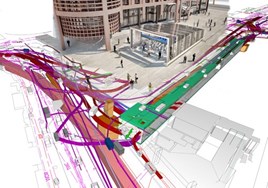 Read the peer reviews for this feature.
Read the peer reviews for this feature.
Download the graphs for this feature.
The first National Infrastructure Plan (NIP) was published in October 2010, setting out projects costing £200 billion over five years in energy, transport, digital communications, flood management, water and waste, and intellectual capital.
It specified a “new hierarchy for infrastructure investment, prioritising the maintenance and smarter use of assets, followed by targeted action to tackle network stress points and network development and, finally, delivering transformational, large-scale projects that are part of a clear, long-term strategy”. This article focuses on the rail component and looks at its relation to other modes.
The rail projects listed ranged from HS2 and Crossrail to the new southern entrance to Leeds station and resignalling schemes for Newport and Cardiff. Inevitably, the rail project list changes only slightly between reports, given the long planning and construction times associated with major projects. However, each report provides an update on progress.
The Government’s process for planning investment in the railway is enshrined in the Railways Act 2005. Every five years, starting with the High Level Output Specification (HLOS) of 2007, the Secretary of State for Transport publishes a statement in which he or she specifies the outputs they want to buy from the railways and the funds to be made available (the SoFA) to fund these outputs.
The HLOS sets out specimen schemes, many drawn from Network Rail’s Initial Industry Plan, which have the capability of delivering the specified outputs within the funding provided. The Office of Rail and Road has the role of verifying this before Network Rail is committed (through the Periodic Review of access charges) to delivering these outputs - these include specified levels of performance, safety and crowding, various projects such as electrification, and meeting efficiency and funding targets.
By the 2011 NIP, the cost of more than 500 projects set out in “a pipeline” had risen to over £250bn, with two-thirds of them to be privately funded in 2011-15. Some may have raised eyebrows when they saw in the March 2012 update the inclusion as a separate item of the Southern franchise agreement with Bombardier for 130 new carriages - the first item of rolling stock investment to appear in the NIP, but not normally classified as infrastructure.
The increase in the average annual infrastructure investment had risen to £33bn for 2010-12 from the £29bn average for 2005-10, driven by increased spend in the energy and transport sectors.
The 2012 ‘pipeline’ contained 550 projects valued at about £310bn, including £320 million for the Northern Hub, a ring-fenced £200m in the HLOS for the Strategic Freight Network, and a new line approaching Heathrow from Slough. The largest announcement was the July 2012 £4.5bn contract between the Department for Transport and Agility Trains for 596 IEP trains and maintenance depots.
The March 2013 update reported the decision to extend electrification beyond Cardiff to Swansea and to include the Valleys network. By the 2013 NIP, the annual average spend had risen to £45bn with a total value up to £375bn, and for the first time the NIP set out the specific rationale for each of the top 40 priority investments. These included the benefits that would accrue from HS2, line capacity improvements and electrification schemes.
The 2013 NIP also made mention for the first time of the regulatory framework for the development and testing of driverless cars. It also recognised that transport and energy had the lion’s share of the plan (schemes in those sectors accounted for £340bn of the £375bn total).
Completed projects
Performance targets also found their way into the 2013 NIP, with a Public Performance Measure target for 2019 of 92.5% of trains arriving on time, and a maximum of 2.2% of trains cancelled or arriving 30 minutes later than advertised.
Another introduction to the 2013 NIP was a changed methodology of measuring improvements in efficiency. From a baseline of 100 in 2005, changes in performance were calculated using a range of inputs such as service quality and reliability, asset condition, efficiency and safety (increased scores are improvements). The only drop related to overcrowding (a high-class problem, as former EWS chief Ed Burkhardt might have said), while some measures recorded dramatic improvements. Asset condition rose to 221, and train frequency to 157.
By 2014, the NIP could record completion of the new concourse at King’s Cross refurbishment as well as more than 400 other station improvements, 90% of tunnelling on Crossrail completed, and Royal Assent for the High Speed Rail Preparation Act. New announcements included a new station at Chesterton (near Cambridge), examination of alternative routes to the vulnerable section of railway through Dawlish, and support for the recommendations of the ‘Norwich in 90’ task force.











